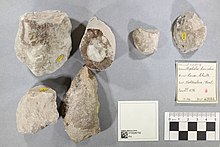Acanthopholis
| Acanthopholis | |
|---|---|

| |
| Assigned dermal scutes
| |
| Scientific classification | |
| Domain: | Eukaryota |
| Kingdom: | Animalia |
| Phylum: | Chordata |
| Clade: | Dinosauria |
| Clade: | †Ornithischia |
| Clade: | †Thyreophora |
| Clade: | †Ankylosauria |
| Family: | †Nodosauridae |
| Subfamily: | †Acanthopholinae Nopcsa, 1923 |
| Genus: | †Acanthopholis Huxley, 1867 |
| Species: | †A. horrida
|
| Binomial name | |
| †Acanthopholis horrida Huxley, 1867
| |
Acanthopholis (
History
Around 1865 commercial fossil collector
In 1867 Huxley named the genus and species Acanthopholis horridus.
The
In 1869
In 1999
Syngonosaurus was synonymised with Acanthopholis in 1999, but the genus was reinstated in a 2020 study, when Syngonosaurus and Eucercosaurus were reinterpreted as basal iguanodontians.[10]
A partial
Description
The armour of Acanthopholis consisted of oval keeled plates set almost horizontally into the skin, with long spikes protruding from the neck and shoulder area, along the spine. Acanthopholis was
Classification
Acanthopholis was originally assigned to the
See also
References
- ^ S2CID 128679805.
- ^ Woodward, A.S.; Sherborn, C.D. (1890). A Catalogue of British Fossil Vertebrata. Dulau & Company. p. 209.
- S2CID 140673032.
- ^ Seeley, H.G. (1869). Index to the Fossil Remains of Aves, Ornithosauria, and Reptilia from the Secondary Strata arranged in the Woodwardian Museum of the University of Cambridge. Deighton, Bell and Company. pp. xvii.
- ISSN 0374-5481.
- ^ H.G. Seeley, 1876, "On Macrurosaurus semnus (Seeley), a long tailed animal with procoelous vertebrae from the Cambridge Upper Greensand, preserved in the Woodwardian Museum of the University of Cambridge", Quarterly Journal of the Geological Society of London 32: 440-444 doi:10.1144/GSL.JGS.1876.032.01-04.50
- S2CID 129277596.
- ^ von Huene, F. (1956) "Palaeontologie und Phylogenie der niederen Tetrapoden"
- ^ Superbiola, X.P.; Barrett, P.M. (1999). "A systematic review of ankylosaurian dinosaur remains from the Albian-Cenomanian of England". Special Papers in Palaeontology. 60: 177–208.
- S2CID 225289654.
- ^ ISBN 9780957453050
- ^ B. F. Nopcsa. 1902. Notizen über cretacische Dinosaurier [Notes on Cretaceous dinosaurs]. Sitzungsberichte der Mathematisch-Naturwissenschaftlichen Classe der Kaiserlichen Akademie der Wissenschaften 111(1):93-114
- ^ B. F. Nopcsa. 1928. The genera of reptiles. Palaeobiologica 1:163-188
References
- Carpenter, Kenneth (2001). "Phylogenetic Analysis of Ankylosauria". In Carpenter, Kenneth (ed.). The Armored Dinosaurs. Indiana University Press. pp. 455–480. ISBN 0-253-33964-2.
